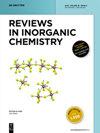Real scenario of metal ion sensor: is conjugated polymer helpful to detect hazardous metal ion
IF 3.1
3区 化学
Q1 CHEMISTRY, INORGANIC & NUCLEAR
引用次数: 1
Abstract
Abstract Metal ions from natural and anthropogenic sources cause pollution to society and the environment is major concern in the present scenario. The deposition and contamination of metal ions in soil and water affect the biogeochemical cycles. Thus, it threatens the everyday life of living and non-living organisms. Reviews on the detection of metal ions through several techniques (Analytical methods, electrochemical techniques, and sensors) and materials (Nanoparticles, carbon dots (quantum dots), polymers, chiral molecules, metal-organic framework, carbon nanotubes, etc.) are addressed separately in the present literature. This review reveals the advantages and disadvantages of the techniques and materials for metal ion sensing with crucial factors. Furthermore, it focus on the capability of conjugated polymers (CPs) as metal ion sensors able to detect/sense hazardous metal ions from environmental samples. Six different routes can synthesize this type of CPs to get specific properties and better metal ion detecting capability in vast research areas. The metal ion detection by CP is time-independent, simple, and low cost compared to other materials/techniques. This review outlines recent literature on the conjugated polymer for cation, anion, and dual ion sensors. Over the last half decades published articles on the conjugated polymer are discussed and compared.金属离子传感器的真实场景:是有助于检测有害金属离子的共轭聚合物
摘要自然和人为来源的金属离子对社会和环境造成污染是当前情况下的主要问题。金属离子在土壤和水中的沉积和污染影响着生物地球化学循环。因此,它威胁着生物体和非生物体的日常生活。本文献分别介绍了通过几种技术(分析方法、电化学技术和传感器)和材料(纳米颗粒、碳点(量子点)、聚合物、手性分子、金属有机框架、碳纳米管等)检测金属离子的综述。这篇综述揭示了金属离子传感技术和材料的优缺点以及关键因素。此外,它还关注共轭聚合物(CP)作为金属离子传感器的能力,能够检测/感知环境样品中的有害金属离子。六种不同的路线可以合成这种类型的CP,以获得特定的性能和更好的金属离子检测能力,在广阔的研究领域。与其他材料/技术相比,CP的金属离子检测是时间无关的、简单且成本低的。这篇综述概述了用于阳离子、阴离子和双离子传感器的共轭聚合物的最新文献。对过去五年来发表的关于共轭聚合物的文章进行了讨论和比较。
本文章由计算机程序翻译,如有差异,请以英文原文为准。
求助全文
约1分钟内获得全文
求助全文
来源期刊

Reviews in Inorganic Chemistry
化学-分析化学
CiteScore
7.30
自引率
4.90%
发文量
20
审稿时长
1 months
期刊介绍:
Reviews in Inorganic Chemistry (REVIC) is a quarterly, peer-reviewed journal that focuses on developments in inorganic chemistry. Technical reviews offer detailed synthesis protocols, reviews of methodology and descriptions of apparatus. Topics are treated from a synthetic, theoretical, or analytical perspective. The editors and the publisher are committed to high quality standards and rapid handling of the review and publication process. The journal publishes all aspects of solid-state, molecular and surface chemistry. Topics may be treated from a synthetic, theoretical, or analytical perspective. The editors and the publisher are commited to high quality standards and rapid handling of the review and publication process.
Topics:
-Main group chemistry-
Transition metal chemistry-
Coordination chemistry-
Organometallic chemistry-
Catalysis-
Bioinorganic chemistry-
Supramolecular chemistry-
Ionic liquids
 求助内容:
求助内容: 应助结果提醒方式:
应助结果提醒方式:


